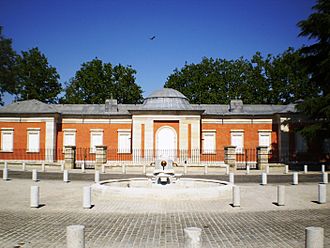Casita del Príncipe (El Pardo) facts for kids
Quick facts for kids Casita del Príncipe |
|
|---|---|
 |
|
| General information | |
| Architectural style | Neoclassical |
| Location | Spain |
| Design and construction | |
| Architect | Juan de Villanueva |
The Casita del Príncipe (which means "Cottage of the Prince" in Spanish) is a special house built in the 1700s. It is located near the Royal Palace of El Pardo, which is a large hunting area just north of Madrid, the capital city of Spain.
What is the Casita del Príncipe?
This beautiful building was designed by a famous architect named Juan de Villanueva. He was known for his Neoclassical style, which means he used ideas from ancient Greek and Roman buildings. The house was made for Charles, who was the Prince of Asturias at the time and later became King Charles IV of Spain. Building the house started in 1784.
Why was it built?
The word casita is a Spanish word that means "little house." These types of small, fancy houses were popular for royal families. They gave the prince a chance to relax and escape from the very formal rules and ceremonies of court life at the main palace. It was a place where he could be more comfortable and private.
Juan de Villanueva actually designed another "Casita del Príncipe" for the same prince in a different location called El Escorial. A famous example of a similar royal retreat is the Petit Trianon at Versailles in France.
Visiting the Casita
Today, the Casita del Príncipe is looked after by an organization called the Patrimonio Nacional. This group takes care of many important historical places in Spain. After some important repair work in the early 2000s, the house is now open for people to visit. You usually need to arrange your visit ahead of time. Inside, you can see amazing artwork, including a special painting called a fresco by an artist named Francisco Bayeu y Subías.
See also

- In Spanish: Casita del Príncipe (El Pardo) para niños

